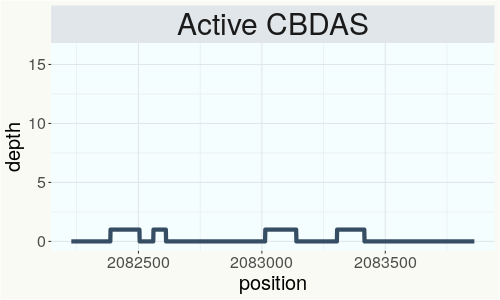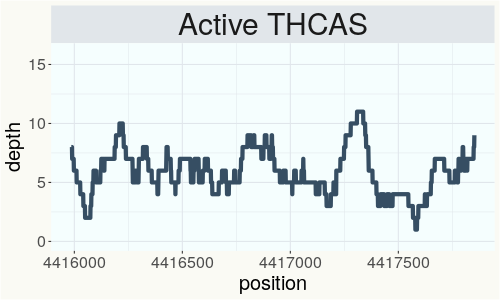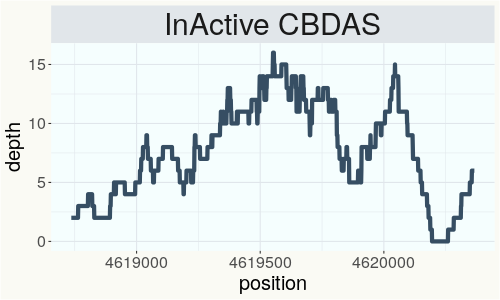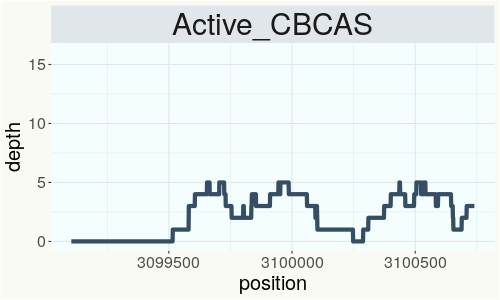Afghan_Kush_1
SRR 3294430
General Information
- Accession Date
- February 7, 2016
- Reported Plant Sex
- Male
- Report Type
- Whole-Genome Sequencing
The strain rarity visualization shows how distant the strain is from the other cultivars in the Kannapedia database. The y-axis represents genetic distance, getting farther as you go up. The width of the visualization at any position along the y-axis shows how many strains there are in the database at that genetic distance. So, a common strain will have a more bottom-heavy shape, while uncommon and rare cultivars will have a visualization that is generally shifted towards the top.
Chemical Information
Cannabinoid and terpenoid information provided by the grower.
Cannabinoids
No information provided.
Terpenoids
No information provided.
Genetic Information
- Plant Type
- Type I
File Downloads
The bell curve in the heterozygosity visualization shows the distribution of heterozygosity levels for cannabis cultivars in the Kannapedia database. The green line shows where this particular strain fits within the distribution. Heterozygosity is associated with heterosis (aka hybrid vigor) but also leads to the production of more variable offspring. When plants have two genetically different parents, heterozygosity levels will be higher than if it has been inbred or backcrossed repeatedly.
The ratio of reads mapped to Y-contigs to reads mapped to the whole Cannabis genome (Y-ratios) has been demonstrated to be strongly correlated with plant sex typing. This plot shows the distribution of Y-ratios for all samples in our database which were sequenced with the same method (panel or WGS) as this sample and where this sample falls in the distribution.

This chart represents the Illumina sequence coverage over the Bt/Bd allele. These are the three regions in the cannabis genome that impact THCA, CBDA, CBGA production. Coverage over the Active CBDAS gene is highly correlated with Type II and Type III plants as described by Etienne de Meijer. Coverage over the THCA gene is highly correlated with Type I and Type II plants but is anti-correlated with Type III plants. Type I plants require coverage over the inactive CBDA loci and no coverage over the Active CBDA gene. Lack of coverage over the Active CBDA and Active THCA allele are presumed to be Type IV plants (CBGA dominant). While deletions of entire THCAS and CBDAS genes are the most common Bt:Bd alleles observed, it is possible to have plants with these genes where functional expression of the enzyme is disrupted by deactivating point mutations (Kojoma et al. 2006).



This chart represents the Illumina sequence coverage over the CBCA synthase gene.

Variants (THCAS, CBDAS, and CBCAS)
No variants to report
Variants (Select Genes of Interest)
| PKSG-2b | c.774G>A | p.Met258Ile | missense variant | moderate | contig700 | 1950864 | C/T | |
| FAD2-2 | c.172G>T | p.Asp58Tyr | missense variant | moderate | contig83 | 1803197 | C/A |
|
| FAD2-2 | c.164A>G | p.His55Arg | missense variant | moderate | contig83 | 1803205 | T/C |
|
| FAD2-2 | c.161T>A | p.Leu54His | missense variant | moderate | contig83 | 1803208 | A/T |
|
| FAD2-2 | c.64G>T | p.Ala22Ser | missense variant | moderate | contig83 | 1803305 | C/A |
|
| aPT1 | c.629C>T | p.Thr210Ile | missense variant | moderate | contig121 | 2840237 | C/T | |
| HDS-1 | c.1618A>G | p.Ile540Val | missense variant | moderate | contig1891 | 885936 | T/C | |
| HDS-1 | c.56C>G | p.Ala19Gly | missense variant | moderate | contig1891 | 889336 | G/C | |
| HDS-1 | c.35G>A | p.Cys12Tyr | missense variant | moderate | contig1891 | 889357 | C/T | |
| AAE1-3 | c.634G>C | p.Gly212Arg | missense variant | moderate | contig976 | 1083220 | C/G |
|
| GGR | c.679G>A | p.Glu227Lys | missense variant | moderate | contig2282 | 549671 | G/A |
|
Nearest genetic relatives (All Samples)
- 0.019 UC 46 (SRR14419703)
- 0.033 UC 167 (SRR14419585)
- 0.047 Triangle Kush x Square Wave BX (RSP12100)
- 0.048 UC 32 (SRR14419761)
- 0.050 UC 34 (SRR14419739)
- 0.056 UC 49 (SRR14419701)
- 0.057 (SRR3294451)
- 0.059 UC 70 (SRR14419679)
- 0.062 Electra (RSP11366)
- 0.063 UC 71 (SRR14419677)
- 0.063 UC 21 (SRR14419861)
- 0.063 Lift (RSP11378)
- 0.065 UC 141 (SRR14419609)
- 0.071 Doug s Varin (RSP11243)
- 0.071 Blue Dream (RSP11010)
- 0.074 East side OG (RSP12089)
- 0.076 UC 18 (SRR14419894)
- 0.078 UC 62 (SRR14419687)
- 0.078 UC 48 (SRR14419702)
- 0.079 (SRR3294441)
Most genetically distant strains (All Samples)
- 0.380 80E (RSP11213)
- 0.362 JL 4th Gen 6 (RSP11200)
- 0.354 80E (RSP11212)
- 0.352 80E (RSP11211)
- 0.348 JL yellow (RSP11075)
- 0.345 JL 3rd Gen Mother (RSP11214)
- 0.339 Fedora 17 (RSP10661)
- 0.333 Carmaleonte (RSP11207)
- 0.329 IBE (SRR14708228)
- 0.328 JL 4th Gen 1 (RSP11193)
- 0.325 JL 4th Gen 5 (RSP11199)
- 0.324 Feral (RSP11205)
- 0.323 JL 3rd Gen Father (RSP11196)
- 0.315 Santhica27 (RSP11047)
- 0.312 Fedora 17 (RSP11203)
- 0.308 Santhica27 (RSP11046)
- 0.308 Monoica (RSP10241)
- 0.305 Northern Lights (RSP11501)
- 0.303 Santhica27 (RSP10056)
- 0.301 Tisza (RSP11044)
Nearest genetic relative in Phylos dataset
- Overlapping SNPs:
- 5
- Concordance:
- 5
Nearest genetic relative in Lynch dataset
- Overlapping SNPs:
- 1
- Concordance:
- 1
Blockchain Registration Information
- SHASUM Hash
-
619d08308a57f9afdccb0ffaf5ecd1b3 6487c4d88065f803 62d61df38a477062